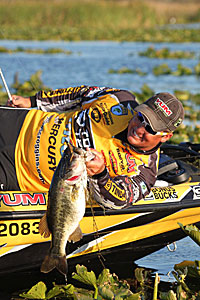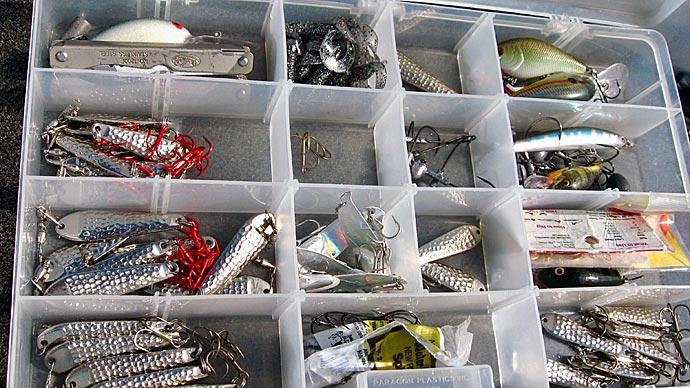
Spoons come in all shapes and sizes. The selection is pretty good, from the teaspoon-shaped Johnson spoon with one big hook to a long, slender slab of lead made for deep water jigging.
Fishing spoons in the heat of summer can be some of the most exciting fishing you will ever do. Over thick hydrilla or lily pads, a Johnson spoon is one of the most effective lures you can ever use to draw bass out from under the thick vegetation. I have had some of the most vicious strikes of my life when fishing spoons over matted grass.
This is not a technique for light-line folks. I recommend using a 50-pound braided line or at least a 25-pound test monofilament. Also, a heavy action rod is a plus.
Setting the hook on a weedless spoon fished on top is the same as any other topwater bait. The angler needs to wait a few seconds after the strike before setting the hook. Let yourself feel a little tension on the rod, then let them have it. I like to set the hook extra hard in vegetation. It helps bring the fish up by getting their head up quicker. It will also give you a better chance of getting them out of the hydrilla or lilies before they bury themselves. Many times, especially with larger bass, they will encase themselves in so much grass you can lose them from the sheer weight.
When a bass buries itself in the grass, turn your trolling motor on high and go after the fish. Net the fish, grass, and all. Once you have finished picking the grass off the fish, you may be surprised by the size of your catch. It's kind of like opening a wet Christmas present.
Sometimes you'll run across a thick patch of grass that is a couple of feet under the water's surface. This is when I modify a Johnson spoon by snipping off at least one-quarter of the weed guard. Then, I push the thick part of a grub or snake-tail worm onto the shortened weed guard leaving the tail to flutter and twist. This is probably the most weedless lure I have ever fished. It will go through hydrilla or coontail grass with ease. Lily pads aren't much of a challenge for this rig, either.
I have used this rig in Carolina fashion, using the spoon as the weight. I tie a leader line off the bend in the hook. You can catch a lot of fish on the spoon and the plastic bait dangling at the end of the leader. Sometimes you'll bring in two at a time, especially when you have one on the worm. When the fish is fighting against the pull it feels from the worm, the spoon is going crazy and will attract other fish that may happen to be nearby.
Many anglers have caught a bass on a crankbait and seen another bass following their catch to the boat, only to have it shy away at the boat. This spoon and Carolina rig will catch many of those bass "buddies" who are in a food competition. This is a technique I have been using for several years, and it has been very effective for me. This is especially good during tournaments when you can improve your catch rate by catching doubles.
I am not satisfied by the sharpness of any of the hooks I have found on spoons. I recommend you take a hook file to them or any other bait. Generally, right out of the package isn't quite as sharp as you can make it with a file. Sharpness is where you get your best penetration.
Another effective spoon in the summer is the old standby true jiggin' spoon. I will use this bait for fishing roadbeds, humps, and points for deep-water fish. Generally, I fish it the same in the summer as I do in winter.
There are two types of spoons I use in the summer. One is a sidewinder spoon. This old spoon is a stamped lure and usually chrome in color. Being a stamped spoon instead of a lead spoon, it is much lighter and has a slow, wobbling fall. Good friend and Lake Fork guide Mike Moody turned me on to this spoon a few years ago. We were fishing some main lake humps. He likes to use the 4- or 5-inch sidewinders. He feels it presents a larger shad imitation and therefore catches larger bass. Sometimes fish want a slow-falling spoon and will hit the sidewinder when they don't touch other types of spoons.
The other spoon I use this time of year is a 1-ounce Critter Getter. This spoon is lead and will get to the bottom faster than a stamped spoon. You can cover more water in a shorter time with this lead spoon.
Sometimes, you will feel the fish hitting the worm weight when fishing a Carolina rig. Put on a spoon and start jigging around in the same areas when this happens. I have had some successful days on the lake by doing this. Usually, it's the other way around. I will use a spoon to locate some active fish in deep water, then turn to a jigs or Carolina rig to entice some of the larger fish in the school.
Bass will get picky now and then and won't hit a piece of plastic. Often, though, these fish will hit a moving spoon right on the bottom. Like my dad always said, you have to give the fish what they want, not what you want.
When you hook a fish on a spoon, you need to keep your rod tip down toward the water. Try to keep the fish's head down. Do not allow them to jump if at all possible. Bass tend to shake heavy lures out. Of course, if your hooks are good and sharp, this should take care of the fish throwing your bait out of its mouth.
Give the spoon and Carolina rig trick a try. It can put a lot of fish in the boat when you need them.




